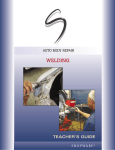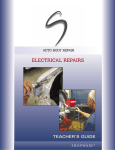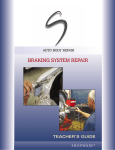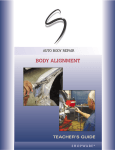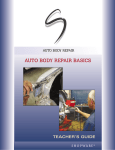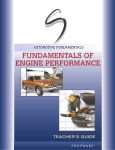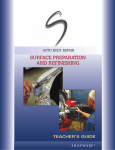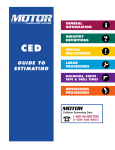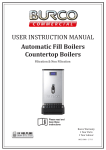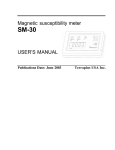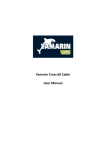Download Dings and Scratches
Transcript
32778 Dings Auto Body TG 10/1/04 10:55 AM Page 1 AUTO BODY REPAIR DINGS AND SCRATCHES TEACHER’S GUIDE S H O P WA R E ® 32778 Dings Auto Body TG 10/1/04 10:55 AM Page 2 INTRODUCTION This Teacher’s Guide provides information to help you get the most out of Dings and Scratches. The contents in this guide will enable you to prepare your students before using the program and present follow-up activities to reinforce the program’s key learning points. As part of the 12-part series Auto Body Repair, Dings and Scratches demonstrates the processes and techniques for repairing minor damage to sheet metal, including how to identify and plan repairs, procedures for performing repairs using various tools and supplies, and techniques for metal finishing. After viewing this video and completing some of the learning activities included in this guide, students will be better prepared to properly identify minor damage, and develop and implement a repair plan for mending dents and scratches using the proper tools and techniques. Use Dings and Scratches and the accompanying activities provided in this guide to prepare students for the most effective way to approach the repair of minor dents and scratches, and to familiarize them with the tools and techniques they will most often use during the collision repair process. LEARNING OBJECTIVES After viewing the program, students will be able to: ■ Demonstrate a basic knowledge of sheet metal repair operations and safety procedures. ■ Identify the correct tools to use given the task to be performed. ■ Explain procedures for identifying damage and plans for repair of sheet metal. ■ Explain procedures for repairing sheet metal panels. ■ Follow proper procedures to repair damaged sheet metal. EDUCATIONAL STANDARDS The primary certifying body for automotive technician training programs is the National Institute for Automotive Service Excellence (ASE). ASE is a non-profit organization established in 1972 by the automotive industry to improve the quality of vehicle repair and service through the voluntary testing and certification of automotive repair technicians. The National Automotive Technicians Education Foundation (NATEF) is a separate non-profit foundation within ASE. The mission of NATEF is to improve the quality of automotive technician training programs nationwide through voluntary certification. The State Departments of Education in all 50 states support ASE/NATEF certification of automotive programs. National Standards This program correlates with the Program Certification Standards for Automobile Technician Training Programs from the National Institute for Automotive Service Excellence (ASE) and the National Automotive Technicians Education Foundation (NATEF). The content has been aligned with the following educational standards, which reflect the tasks in the ASE Program Certification Standards for Automobile General Service Technician Programs. Copyright © 2005 SHOPWAR E ® 2 32778 Dings Auto Body TG 10/1/04 10:55 AM Page 3 Outer Body Panel Repairs, Replacements, and Adjustments ■ Determine the extent of the direct (primary) and indirect (secondary) damage and the direction of impact; plan the methods and order of repair. ■ Remove and replace bolted, riveted, bonded, and welded panels; repair, weld, or replace. ■ Check and adjust clearances of front fenders, header, and other panels. ■ Restore contours of damaged panel to a surface condition suitable for metal finishing or body filling. ■ Apply protective coatings and sealants to restore corrosion protection. ■ Repair or replace plastic panels. Metal Finishing and Body Filling ■ Remove paint and other materials from the damaged area of the body panel. ■ Cold shrink stretched panel areas to proper contour. ■ Metal finish the damaged area of a body panel to eliminate surface irregularities. ■ Prepare surface for application of body filler material. ■ Mix and apply plastic body filler; shape during curing. ■ Sand cured plastic body filler to contour. 2004 Automobile Program Standards, by the National Institute for Automotive Service Excellence (ASE), Copyright 2004 Reprinted with permission. Language Arts and Communication Standards According to ASE/NATEF standards, the automobile technician must be proficient in the following Language Arts and Communications related academic skills that are embedded in the occupation. The activities and information presented in this program and accompanying teacher’s guide are aligned to the following standards from the National Automotive Technicians Education Foundation from the National Institute for Automotive Service Excellence. ■ Request, collect, comprehend, evaluate, and apply oral and written information gathered from customers, associates, and supervisors regarding problem symptoms and potential solutions to problems. ■ Identify the purpose for all written and oral communication and then choose the most effective strategies for listening, reading, speaking, and writing to facilitate the communication process. ■ Adapt a reading strategy for all written materials, e.g. customer’s notes, service manuals, shop manuals, technical bulletins, etc., relevant to problem identification, diagnosis, solution, and repair. ■ Use study habits and techniques, i.e. previewing, scanning, skimming, taking notes, etc., when reviewing publications (shop manuals, references, databases, operator’s manuals, and text resources) for problem solving, diagnosis, and repair. ■ Write clear, concise, complete, and grammatically accurate sentences and paragraphs. ■ Write warranty reports and work orders to include information regarding problem resolution and the results of the work performed for the customer or manufacturer. ■ Follow all oral/written directions that relate to the task or system under study. 3 32778 Dings Auto Body TG 10/1/04 10:55 AM Page 4 ■ Comprehend and apply industry definitions and specifications to diagnose and solve problems in all automotive systems and components of the automobile and light truck. ■ Comprehend and use problem-solving techniques and decision trees that are contained in service manuals and databases to determine cause-and-effect relationships. ■ Use the service manual to identify the manufacturer’s specifications for system parameters, operation, and potential malfunctions. ■ Supply clarifying information to customers, associates, parts supplier, and supervisors. Technology Standards The activities in this Teacher’s Guide were created in compliance with the following National Education Technology Standards from the National Education Technology Standards Project. The content has been aligned with the following educational standards and benchmarks. ■ Use a variety of media and formats to communicate information and ideas effectively to multiple audiences. ■ Use telecommunications to collaborate, publish, and interact with peers, experts, and other audiences. ■ Use productivity tools to collaborate in constructing technology-enhanced models, prepare publications, and produce other creative works. ■ Use technology tools to enhance learning, increase productivity, and promote creativity. ■ Use technology to locate, evaluate, and collect information from a variety of sources. The National Education Technology Standards reprinted with permission from the International Society for Technology Education. PROGRAM OVERVIEW The majority of auto body repairs fall under the category of minor damage, specifically dings and scratches. Usually, these damages are too extensive to simply fill in with body filler, but are too small to require a new panel. This video shows how to assess sheet metal damage, plan for and perform minor sheet metal repairs using various tools and supplies, and refinish surfaces. A slide hammer dent puller, weld-on pulling tool, body hammer and dolly, and other tools of the trade are demonstrated. After viewing this program, viewers will be better prepared to properly assess, plan for, and repair minor collision damage using the appropriate tools and techniques. MAIN TOPICS Topic 1: Introduction to Sheet Metal Tools and Supplies This section introduces the hand tools, power tools, and supplies that are used to repair minor dents without drilling holes in the sheet metal. Students will view a brief demonstration of an auto body repair professional using a slide hammer and dent puller with a spot welder. 4 32778 Dings Auto Body TG 10/1/04 10:55 AM Page 5 Topic 2: Preliminary Tasks This section of the program describes procedures for examining and assessing the extent of damage, determining whether repair or replacement makes the most sense, the importance of devising a repair plan, and safety precautions to take prior to beginning the repair process. Topic 3: Repairing Damaged Sheet Metal This section demonstrates the procedures for repairing damaged sheet metal using power tools, hand tools, a stud welder, and auto body supplies. Students will learn the tools and supplies most applicable for each type of repair, and the step-by-step procedures to repair damaged panels that present varying levels of accessibility. Topic 4: Basic Metal Finishing Techniques This section of the program demonstrates basic techniques for preparing the surface of metal panels using a variety of supplies and tools. Students will learn safety rules and guidelines for mixing and applying various types of body filler, primer, and putty in preparation for the final finish. FAST FACTS ■ Most auto body repairs fall under the category of minor damage: dents and dings too big to fill, but too small to need a new panel. As a result, the repair of minor panel damage to sheet metal is probably the most common task auto body repair technicians will encounter in collision repair. ■ Before beginning any repair, auto body repair technicians must assess the extent of the damage by looking at the point and direction of impact to determine the starting point for the initial inspection. Some damaged parts may have to be removed to determine indirect damage to parts that are not immediately visible. Areas to note are scrapes, buckling, and panel misalignment or movement. ■ Drilling holes to pull out dents is no longer an accepted practice for dent repair. ■ The repair or replacement of damaged panels is determined by estimating the length of time it will take to remove and replace the damaged panel, plus the cost of a replacement part compared to the amount of time for panel repair. ■ For some parts, such as quarter panels, which are welded or bonded into place, removing and installing a replacement is a very time-consuming task, taking 12 to 14 hours plus the cost of the replacement part. Repairing rather than replacing is often a time and money-saving option. ■ After examining and assessing the extent of damage, auto body repair technicians should develop a detailed, step-by-step repair plan to identify and organize the parts and supplies needed prior to beginning repairs, and to organize the repair process so no critical steps are overlooked. ■ Practice proper safety precautions to avoid bodily injury and property damage. Wear protective safety glasses and have a dust mask handy. Protect undamaged areas adjacent to the repair by covering windows or removing and storing trim and other parts near the repair area. 5 32778 Dings Auto Body TG 10/1/04 10:55 AM Page 6 ■ Roughing out the damaged areas means to return them as close as possible to the vehicle’s original contours by lowering high spots and raising low spots. The area should be within 1/8 of an inch of the original contour before applying any body filler. ■ Roughing out a damaged area usually requires gaining access to the backside of the damaged panel by removing interior panels and hardware. ■ If damage is minor and there is enough access to the back side of the panel, use body hammers, dollies, and spoons. ■ If damage is minor and there is limited access to the back panel, use body picks or pry bars. ■ If there is no access to the back of the panel, use a spot welder (stud) with a slide hammer and dent puller. ■ The surface of the hammer and the dolly should match as closely as possible the original contours of the panel being repaired. Heavier hammers should be used for roughing out while lighter finishing hammers should be used for final shaping. ■ When grinding off any remaining paint, weld scale or corrosion in a patch area in preparation for a spot weld, and remove paint from the damaged area and 3 to 4 inches around it while trying to remove as little of the metal as possible. ■ Dents should be roughed out within 1/8 inch of the original contour. ■ Use of a stud spot welder during minor collision repairs eliminates the need to punch or drill a hole in the panel. Holes destroy rust proofing and provide an ideal spot for corrosion to set in. ■ Proper surface preparation is critical to the success of body filler adhesion and includes removal of all dirt, grime, wax, grease, road tar, and any silicone from automotive waxes. VOCABULARY TERMS body filler: Durable filler consisting of two parts: the base filler and the hardener, which is used to fill low spots within 1/8 inch or less of the original surface contour. body filler mixing board: A board made of glass, plastic, or metal used to mix body filler. body hammer: A tool used for shrinking high areas of sheet metal to level the surface to its original contour by starting with light blows on the edge and working toward the middle. bumping hammer: A tool used in conjunction with a dinging spoon to work down high spots and bump out low spots during the spring hammering process. bubbles: Air trapped in body filler caused by excessive stirring. dent puller: A tool that is used with a slide hammer and a spot welder to pull out a dent when interior trim or body panels prevent access to the backside of the damaged panel. dinging spoon: A tool used to smooth out and level dings (low spots) when the back of the panel is not easily accessible with a dolly. When held against the ridge of a dent and struck with a hammer, this tool spreads the blow over a large area. disc sander: A tool that uses sandpaper to grind off remaining paint, weld scale, or corrosion in a patch area. dolly: A large chunk of steel with a slightly curved flat side to pound against. glazing putty: Fine filler consisting of two parts: the base filler and the hardener, which is used to fill in scratches that cannot be buffed out. 6 32778 Dings Auto Body TG 10/1/04 10:55 AM Page 7 hammer-off-dolly: A technique for roughing out a large buckle by placing the dolly under a low spot while striking an adjacent high spot with the hammer. This action causes the hammer to drive the high spot down, while the rebounding dolly drives the low spot up without stretching the metal. hammer-on-dolly: A technique for straightening metal by holding the dolly directly behind the high spot, and firmly pressing it against the metal while striking the opposite side with light hammer blows. This technique requires that both the hammer head and dolly surface match the desired shape of the panel. If the area is flat, a flat dolly and hammer should be used. If the area is curved, both the dolly and hammer head should match the curve as closely as possible. pick: A tool that is often inserted into an existing hole to push or pry up metal in areas that can’t be reached with spoons; often used in place of a pry bar. polyfiller: Liquid body filler consisting of two parts: the base filler and the hardener, which is sprayed on to fill in all of the pinholes and minute scratches for which body filler or glazing putty is not suitable. primer: A material that is applied over bare metal to promote the adhesion of surfacer material. Failure to prime bare metal areas often results in the paint peeling off later. pry bar: A tool that is often inserted into an existing hole to push or pry up metal in areas where there is limited access to the back panel or where the area cannot be reached with spoons; often used in place of a pick. rough out: The process of lowering high spots and raising low spots to return them as close as possible to the vehicle’s original contours. shrinking hammer: A tool used to shrink metal in a raised area to restore the original contour. slide hammer and dent puller: A metal rod with a tool at one end, and a heavy weight that slides on the rod to pull or push the tool. Used with a spot welder to pull out a dent. spring hammering: A dent repair technique that uses a dinging spoon held firmly against the back of a ridge or crease, while a bumping hammer is used to hit the surface of the ridge to work down high spots and bump out low spots. stud spot welder: A welding gun that welds studs (pins) onto the surface of the dented metal panel; used with a slide hammer that attaches to the studs and pulls out the dent. surfacer: A material that is used to fill in the fine grooves left from sanding, which promotes the adhesion of the final finish. weld-on pulling tool: A tool that is a variation of the slide hammer and dent puller (two tools in one). The slide hammer part of the tool is used to pull out the dent after the tip of the weld gun is actually welded to the dent. This tool eliminates drilling holes in panels to pull dents. PRE-PROGRAM DISCUSSION QUESTIONS 1. What are some typical casues of minor panel damage to sheet metal on a car or truck? 2. Have you ever painted a room? If so, describe the major steps in the painting process. 3. How do the steps for painting a room relate to the repair of minor collision damage? 4. What do you think might happen if a critical step is missed during the repair process? 5. Today, the repair of minor collision damage no longer includes drilling holes to pull out dents. Why do you think this is the case? 7 32778 Dings Auto Body TG 10/1/04 10:55 AM Page 8 POST-PROGRAM DISCUSSION QUESTIONS 1. Now that you have seen the Dings and Scratches video, why do you think an auto body repair professional should rough out a damaged area to within 1/8 of an inch of the original contour before applying any body filler? 2. After inspecting a damaged quarter panel on a vehicle, an auto body repair technician decides to repair the quarter panel rather than replace it. What factors may have influenced the technician’s decision? 3. When straightening metal, why should auto body repair technicians start with a light touch— small taps, light pressure—and work up to harder blows and pressure if needed? 4. What can happen if too much or too little hardener is added to the plastic filler and then applied to a damaged panel? 5. Why might an auto body repair professional use a body pick or pry bar rather than a slide hammer and dent puller? GROUP ACTIVITIES What’s My Line? In the video, participants learn about different procedures and techniques to repair minor dings and scratches using specific tools and supplies. Divide the class into groups of three. Assign one tool or supply to each group (e.g., body filler, body hammer, dent puller, dinging spoon, dolly, glazing putty, primer, slide hammer and dent puller, stud spot welder, weld-on pulling tool). Instruct each group to research and document the characteristics of the assigned tool or supply. Characteristics to consider include appearance, purpose, when the tool or supply is used, procedures or techniques for use, safety considerations, etc. Participants may use the Internet, reference the Dings and Scratches video, consult the instructor, etc. to gather information. After all information is gathered, play What’s My Line? as follows: One three-person group forms a panel in the front of the room; panel members are referred to as #1, #2, and #3. During a defined period of time, the class asks the panel questions that require a YES or NO response to try to determine which tool or supply the panel represents. For example, if the panel has assumed the identity of hardener, the class could ask: — Are you used to pull out a dent? (No) — Do you play a part in the surface preparation process? (Yes) — Are you used to apply finishing material? (No) — Do you come in a can? (No) — Do you come in a tube? (Yes) — Are you always used with other compatible material? (Yes) After the time is up, the instructor asks participants to write down the identity (tool or supply) of the panel before calling upon a volunteer to reveal his/her guess. After correctly revealing the identity of the panel, another three-person group forms the next panel. The game is played 8 32778 Dings Auto Body TG 10/1/04 10:55 AM Page 9 until all students have appeared on a panel. Note: The instructor will know the identity of each panel and preside over the questioning period, guiding students when necessary. Tool Time Divide the class into four groups, and provide them with art supplies (pencils, magic markers, scissors, glue, etc.) and poster board. Instruct students to draw two columns, one being twice as wide as the other, and then to divide the columns into twelve rows. The first row of the left column will be labeled “Tool / Supply” and the first row of the right column will be labeled “Function / When To Use”. Instruct students to draw the tools/supplies used for minor collision repair in the left column (list provided below), and insert a brief description in the right column of the function of the tool/supply and when it should be used. Tools / Supplies: Body Hammer; Bumping Hammer; Dent Puller; Dinging Spoon; Dolly; Pick; Pry Bar; Shrinking Hammer; Slide Hammer and Dent Puller; Stud Spot Welder; Weld-on Pulling Tool. Example: Tool/Supply (Drawing of stud spot welder) Function/When to Use • A welding gun that welds studs (pins) onto the surface of the dented metal panel • Used with a slide hammer that attaches to the studs and pulls out the dent. • Used when there is no access to the back of the panel. Friendly Feud The video presents valuable information about repairing minor damage to sheet metal, including tools and supplies, preliminary tasks, and repair and finishing procedures and techniques. Divide the class into two teams, have them choose a team name, and provide each team with ten index cards. Instruct the students to write one repair-related question on one side of the card, and the corresponding answer on the back. Collect the completed cards from each team and place them in two separate boxes (one box for each team). Instruct each team to choose five players to form a panel. Appoint an audience member to keep score during the game. Each player will take turns choosing a question submitted by the other team from the box. The first player on one team will give the instructor the chosen card. The instructor will read the question and the player will attempt to answer it. If a player answers correctly, a point is awarded to his/her team. Likewise, if a player answers incorrectly, a point is subtracted. Any audience member may then attempt to answer questions that were answered incorrectly, but no points will be awarded. The instructor will announce the winner after all questions have been read. 9 32778 Dings Auto Body TG 10/1/04 10:55 AM Page 10 INDIVIDUAL STUDENT PROJECTS Prepare a Scavenger Hunt List Your car has just suffered minor damage to the left quarter panel. Fortunately, there is enough access to the back side of the panel to make repairs. You have determined that repair is more economical than replacement. You have solicited the help of Boy Scouts to conduct a scavenger hunt in order to gather the tools and supplies needed to rough out the damaged area and prepare the surface of the panel in preparation for the final finish. You must prepare a scavenger hunt list for the Scouts. Based on the clues provided in this description, create a comprehensive list of tools and supplies that you will need to repair the minor damage. You may consult several sources to help you create the list, such as the Dings and Scratches video, the Internet, collision repair magazines, etc. Top Ten After roughing out the damaged areas and returning them as close as possible to the vehicle’s original contours, the second phase in the minor collision repair process is preparing the surface of the metal panel in preparation for the final finish. Surfacing material must be applied using a variety of tools and supplies, as well as specific techniques for the given material. Prepare a list of The Top Ten Things Auto Body Repair Technicians Should Do During Metal Surface Preparation. Think about safety rules, as well as guidelines for mixing and applying materials such as body filler, primer, and putty. Step #10 should be the first step in the surface preparation process; Step # 9 should be the second step, and so forth. Step #10 is provided below to get you started: #10. To remove all dirt, grime, wax, grease, road tar and any silicone from automotive waxes, the auto body repair technician should clean the surface using soap and water, and then dry the area with a clean cloth. Preliminary Steps Pamphlet Conscientious auto body repair technicians know the four Ps of approaching repairs—Prior Planning Prevents Panic! The Dings and Scratches video discussed certain procedures that must be performed prior to beginning the repair process. Prepare a checklist of tasks auto body repair technicians should perform before actually beginning minor repairs. After finalizing the list, design a pamphlet to accommodate the checklist. Consult the Dings and Scratches video, the Internet, fellow classmates, and any other sources that you have available. Categorize the tasks by similarities. Some areas to consider include: Damage Assessment, Course of Action, Planning, and Safety. Include checkboxes after each task and jazzy graphics or drawings. Be prepared to share your brochure with the class. 10 32778 Dings Auto Body TG 10/1/04 10:55 AM Page 11 INTERNET ACTIVITIES Tech Tips Many auto body repair web sites include links to Web pages that offer tips and tricks on various subjects. Visit Web sites that contain tips about dent removal and scratch repair (you may want to start at www.metalshapers.org). Jot down five good tips that fellow classmates may find interesting or helpful. Students will then share their tips with the class, and vote on the most interesting or helpful tip presented. Discussion Forums Visit www.autobodyonline.com and enter the discussion forums by clicking the “Discussion” tab in the upper left corner of the Web page. Post a question about minor collision repair. Ask about techniques that experienced auto body professionals have successfully used in the past. Also, review the other posts within the forums and see if you can gather any other information about preliminary steps, safety considerations, proper procedures, surface preparation, etc. After a week, copy all your responses, as well as any other posts you have seen that are relevant, into a word processing document. Then answer the following questions: What have you learned as a result of the answers you have received to your post? What have you learned from reading other posts? Did any of the responses conflict with one another? If so, what issues did they raise? ASSESSMENT QUESTIONS Q: Technician A says that the hammer-off-dolly method to rough out a large buckle is performed by placing the dolly under a low spot while the hammer is applied to a high spot just to the side of the dolly. Technician B says that the hammer-off-dolly technique raises the low spot and lowers the high spot simultaneously without stretching the metal. Who is correct? (a) Technician A (b) Technician B (c) Both A and B (d) Neither A nor B A: (c) Feedback: The hammer-off-dolly method to rough out a large buckle is performed by placing the dolly under a low spot while the hammer is applied to a high spot just to the side of the dolly. This technique raises the low spot and lowers the high spot simultaneously without stretching the metal, which is why the hammer-off-dolly method works well to rough out a large buckle. Q: Which one of the following materials is used to fill surface pinholes and deep scratches that cannot be buffed out? (a) Glazing putty (b) Sprayable polyfiller (c) Body filler (d) Both A & B 11 32778 Dings Auto Body TG 10/1/04 10:55 AM Page 12 A: (d) Feedback: Glazing putty is used to fill fine pinholes. Sprayable polyfiller is used to fill in pinholes and minute scratches not suitable for body filler or glazing putty. Q. Which hand tool is used in conjunction with a dinging spoon to work down high spots and bump out low spots during the spring hammering process? (a) Dent puller (b) Bumping hammer (c) Slide hammer (d) Stud spot welder A: (b) Feedback: The spring hammering process is a dent repair technique that uses a dinging spoon held firmly against the back of a ridge or crease, while a bumping hammer is used to hit the surface of the ridge to work down high spots and bump out low spots. Q: When mixing filler and hardener together on the filler mixing board, why should auto body repair technicians use a back and forth scraping motion rather than stirring the mixture? A: Stirring the mixture causes air bubbles to form. Feedback: When combining filler and hardener, mix the filler and hardener together using a back and forth scraping motion. Stirring the mixture will cause air bubbles to form. Air in the compound will result in the filler curing unevenly. Q: Auto body repair technicians should only mix body filler and hardener compounds made by the same manufacturer. (True or False) A: True Feedback: Body filler should only be mixed with hardener that is made by the same manufacturer to ensure compatibility of both compounds. Q: Technician A says that a stud spot welder and studs should be used in conjunction with a slide hammer and dent puller to pull out a dent when there is no access to the back of the panel. Technician B says that when using a stud spot welder, it is not necessary to remove paint before welding the stud to the dent. Who is correct? (a) Technician A (b) Technician B (c) Both A and B (d) Neither A nor B A: (a) Feedback: A stud spot welder and studs are used in conjunction with a slide hammer and dent puller to pull out a dent when there is no access to the back of the panel. However, before welding the stud to the dent, you must remove the paint in the damaged area. Q: A(n) _____________________helps auto body repair professionals to organize both the parts and supplies needed for an upcoming repair and the process that follows so no critical steps are missed. A: repair plan Feedback: A repair plan is essential to a successful repair job. 12 32778 Dings Auto Body TG 10/1/04 10:55 AM Page 13 Q: Which hand tool should be used to push or pry up metal in areas that cannot be reached with spoons? A: A pick Feedback: Picks can often fit through existing holes, eliminating the need to remove interior trim or panels to reach the damaged area. Q: Why is primer applied to bare metal before applying any other surface materials? A: Primer promotes adhesion of surface materials. Feedback: If bare metal is showing, it must be primed before surface materials, such as surfacer or paint, are applied. Primer promotes adhesion of the surface materials. If bare metal areas are not primed, there is the risk of paint peeling off later. Q: A damaged area should be within 1/4 of an inch of the original contour before applying any body filler. (True or False) A: False Feedback: Roughing out the damaged areas is the process of returning them as close as possible to the vehicle’s original contours by lowering high spots and raising low spots. The area should be within 1/8 of an inch of the original contour before applying any body filler. ADDITIONAL RESOURCES WEB SITES Auto Body Online www.autobodyonline.com Auto Body P.I. www.autopi.com/frame.htm Auto Body Pro www.autobodypro.com Auto Body Tool Mart Repair and Restoration Tutorials www.autobodytoolmart.com/restorations.html Automotive Body Repair News www.abrn.com/abrn Auto Glossary www.autoglossary.com 13 32778 Dings Auto Body TG 10/1/04 10:55 AM Page 14 Automotive Services Association® www.asashop.org Automotive Youth Educational Systems (AYES) www.ayes.org/index.asp Collision Repair Industry: Insight http://www.collision-insight.com How Stuff Works—Auto Stuff Page auto.howstuffworks.com I-car www.i-car.com Metalshapers Association http://www.metalshapers.org National Automotive Service Task Force www.nastf.org National Automotive Technicians Education Foundation www.natef.org Society of Collision Repair Specialists www.scrs.com Tektips—Auto Body Pro Website www.autobodypro.com/tektips.htm BOOKS Duffy, James E. I-CAR Professional Automotive Collision Repair. Albany, NY: Delmar Thomson Learning, 2001. ISBN: 0766813991 Duffy, James E. Auto Body Repair Technology, 4th Edition. Clifton Park, NY: Thomson/Delmar Learning, 2003. ISBN: 0766862747 Killingsworth, Jeff, Eric Godfrey, and John H. Haynes. The Haynes Suspension, Steering And Driveline Manual. Newbury Park, CA: Hayes North America, 1998. ISBN: 1563922932 14 32778 Dings Auto Body TG 10/1/04 10:55 AM Page 15 OTHER PRODUCTS Automotive Technicians, VHS/DVD, Cambridge Educational Sponsored by the National Automotive Technicians Education Foundation (NATEF), this program explores automobile repair and collision repair. NATEF works closely with Automotive Service Excellent (ASE), the nation’s only industry-wide certification program for automotive technicians. Technicians with a sound education have a choice of career avenues. Aside from fixing cars and trucks, they can become service managers, service engineers, automotive writers, or even auto technology teachers. Order #: 24924, www.cambridgeeducational.com, 1-800-468-4227 Automotive Technology Posters It only takes a glance to see that today’s cars have more in common with the space shuttle than they do with the “horseless carriage” of a century ago. This no-nonsense 16-piece poster set will help students quickly and easily develop a familiarity with the many complicated subsystems common to domestic and foreign cars. Correlates to the National Automotive Technicians Education Foundation (NATEF) standards for automotive technology. Order #: 31098, www.meridianeducation.com, 1-800-727-5507 15 32778 Dings Auto Body TG 10/1/04 10:55 AM Page 16 S H O P WA R E ® 2572 Brunswick Pike, Lawrenceville, NJ 08648 w w w. s h o p w a r e - u s a . c o m Call Toll Free: 800/487-3392 32778
















